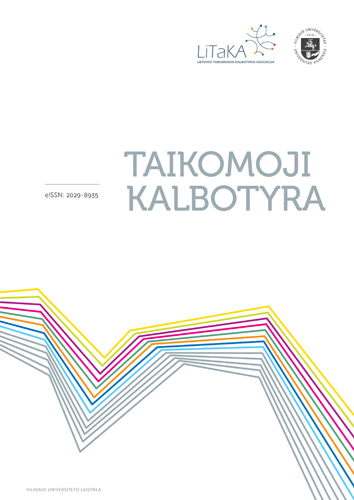„Skolos bijosi – turtų nepadarysi“. Leksikos skolinimosi poreikiai ir polinkiai 1991–2013 m. rašytiniuose tekstuose
Needs and trends of lexical borrowing in written Lithuanian in 1991-2013
Author(s): Loreta VaicekauskienėSubject(s): Lexis, Semantics, Descriptive linguistics
Published by: Vilniaus Universiteto Leidykla
Keywords: new borrowings; global language contacts; English borrowings; database of lexical borrowings; adaptation of borrowings; origin of borrowings; semantic fields;
Summary/Abstract: The paper introduces available databases of new borrowings into Lithuanian and research into their main features and usage in public written texts, including the Internet, in 1991–2013. The research has shown that new borrowings of the Lithuanian language and the process of borrowing follow the same universal and general patterns noticed in other speech communities. Overall, about 1 500 different new borrowings and borrowed derivatives that have entered the Lithuanian language since early 90ies have been included into the databases. Due to the normative tradition of standard written Lithuanian, in more formal domains there is a tendency to graphically highlight borrowings either by inserting the quotation marks or by writing the borrowings in italics. However, in informal Internet texts (chats, commentaries, etc.) the borrowings are usually not highlighted. The morphological adaptation of most borrowings and orthographical adaptation of a large part of them give a clue to the integration potential of the Lithuanian structural paradigms. The distribution of the new borrowings across the word classes follows the patterns identified in other research: most borrowings are nouns, a much lower number of them are adjectives and verbs and a rather insignificant number are adverbs. Most new borrowings in the studied period include borrowings from English (approx. 70 per cent). Borrowings from other languages are much less numerous: depending on atext type, neo-Latinisms make up 5–8 per cent, words of French origin—3–7 per cent, words of Italian origin—4–5 per cent and Greek borrowings—2–3 per cent. The domains that include most new borrowings are technology and engineering, food, economics and bussiness, also music. As already mentioned, borrowings from English clearly dominate in most domains. However, the semantic field of food seems to be the most diverse in terms of the origin of borrowings: most borrowings are of Italian origin, others come from of English, French, Spanish, Japanese and other languages. French and neoclassical borrowings make up more than 70 per cent of all borrowed legal terms and almost 40 per cent of the terms of economics and business. The research of new borrowings into Lithuanian reveals fundamental changes in the sociocultural development of the society and highlights the potential of the Lithuanian language to adapt to the needs of the speakers and to preserve the marks of ongoing cultural changes.
Journal: Taikomoji kalbotyra
- Issue Year: 2014
- Issue No: 3
- Page Range: 1-33
- Page Count: 33
- Language: Lithuanian

